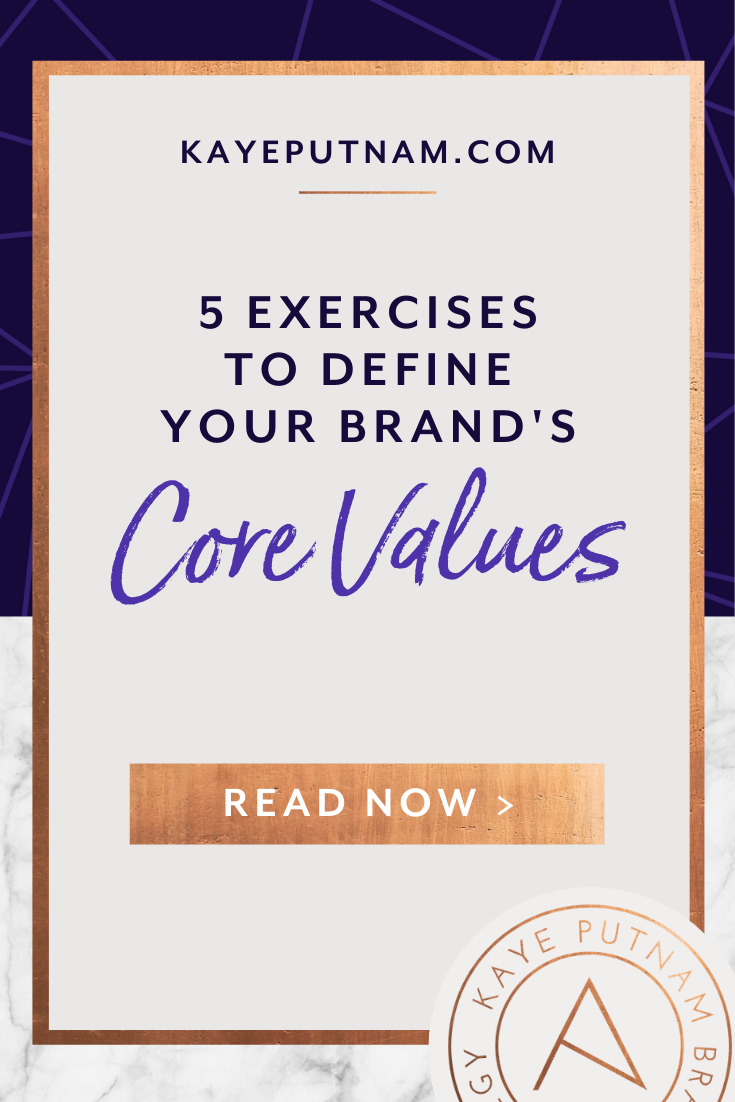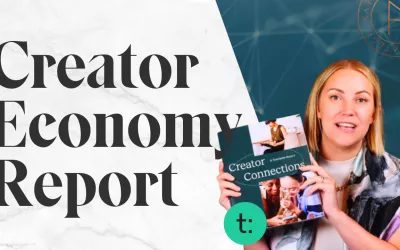What do you believe?
One thing I firmly believe is this:
Your most audacious dreams are worth working for.
It’s never easy, but it is SO worth it. You are worth it.
You are worth taking the next BIG step.
The statement above is actually an excerpt from my Sourcebook – the guiding document behind my own brand. It comes from the section I call “Points of View.”
When defining and deciding a brand’s core values, my clients and students often find it helpful to think of their brand values simply as their unique points of view.
➡️ Because “Core Values” sounds a little stodgy, ammiright? Like something that’s posted in the break room at a corporate office… something that’s internal, not customer-facing.
But I believe your brand’s core values should be definitely perceived by your prospects and customers. I believe they should serve as throughlines in all of your external messaging. And the first step is to articulate your brand’s points of view (or core values 😉) – so you can weave them into your messaging and to inform your visual “language,” – like your logo, colors, fonts, etc.
But sometimes, you need help extracting what’s inside of your head – and translating it into those consumer facing cues. So, in this article, I’m sharing the five exercises that I facilitate with my clients and students to do just that… to articulate the unique points of view that will define their singular brands.
🎥 As usual, I want to meet you where YOU are. So, if you learn best via video, watch below! If you’re partial to reading, then continue on…
Exercise 1: “I Believe…”
Pull out a piece of paper, and number each line – as far as you can go (perhaps to 25 or 30). Now on every line, write a sentence that starts with the two words “I believe”.
(Pssst… just a heads up… This exercise is deceptively simple… but so impactful. Seriously, do this!)
Feel free to “warm up” with a few statements that feel safe and maybe even a little “ho-hum.”
But, as you go, start to dig deeper. Aim to document some opinions that may be uncommon – even unpopular. Because that’s where you’ll find your special sauce – and where you’ll truly differentiate yourself from the pack. Think about topics kind of trigger you or just get you fired up – and write an I believe statement about that.
And for the best results, get specific. Don’t just write, “I think everyone should be happy.” Explore the edges of your opinion. People should be happy at what cost? What should they do to get happy? What do they have to give up to be happy? Take a stand.
Last bit of guidance: When you’re writing your I believe statements, you don’t have to just think about your product or service specifically. Write about your industry. Write about really big human topics like: What do you believe about success? What do you believe about family? About relationships? About work-life balance? What do you believe about personality? Does it change? Do people change or are people always the same?
Exercise 2: The Change You Want to See in the World
“This is the change that we want to see in the world…”
In other words, what is broken?
What’s wrong with this world? What do you want to see changed? What are you being called to improve?
Certainly, humans in every corner of the world have problems. So, there are many from which to choose. And I believe 😉 that entrepreneurs can apply their unique geniuses to solve a variety of dilemmas. But, what are you being drawn to? What is your individual quest or mission for change?
Remember, too, that problems come in all shapes and sizes. You might not be inventing a system for water purification in the third world [or maybe you are!]… but all humans’ problems are worth solving. So, whether you’re helping people banish under-confidence… helping them choose oils that will make them feel better… helping them be more effective and loving parents… your work is important to people.
So, what change do you want to affect in the world?
Pin this article to reference later! 📌

Pin this article to reference later! 📌
Exercise 3: Your Brand’s Legacy
Here’s your prompt for Exercise 3:
“What is your brand’s legacy?”
Think of this in this way: What impact does my brand have on my client’s grandchildren?
And… What’s that ripple effect? How does this affect people I’m helping right now, but also – How does that impact their children? Or their friends? Or the communities in which they live and work?
One thing I love about this exercise is that, once you start to think about that ripple effect, you get down to that stuff that really matters.
I’ll use myself as an example.
If I can help somebody grow a successful business – and a system that naturally attracts their ideal clients to them, the ripple effect might include the following:
I’m helping to show their children that entrepreneurship is a viable career path – that it’s not just a pipe dream. Their kids will see that you don’t have to wait for permission from somebody else to assign you some value. You get to decide how you best serve the world and you can build a business around that.
I’m helping the members of their community that they will, in turn, impact. When I helped a relationship and intimacy coach craft her brand, I had an impact on the strong marriages that she supports. When my work helped a jewelry designer teach her craft to other women through courses, I made a difference to those students.
This exercise is also a potent one. It will inform your brand strategy… and it will also have a positive influence on your mindset. For me, it never fails! This “ripple effect” always gets me all fired up. 💥 💥 💥
So, think about your product or service – and what are the indirect, residual effects it has on other people?
Exercise 4: Your “Bothers” List
Core value exercise number 4 is all about the flip side of your beliefs.
And, although this isn’t the most fuzzy and positive of all the prompts 🤣 – it can be extremely illuminating.
(Also worth noting: If you’ve had any trouble getting into it with the first few prompts, this one might be just the ticket! Sometimes it’s easier to hone in on what you don’t like… on the way to what you do.)
This exercise is probably best done on an ongoing basis – but you can get started right now. Start by identifying a spot where you can begin to gather a list of things that bug you… A new google doc, a notebook, an Asana project… a tool you can bookmark and easily access when you stumble upon something that irks you!
Then, begin to pay attention when you encounter an opinion, a post, a trend, etc that triggers you, or just makes you sort of shake your head.
Maybe someone posts something on social that you don’t agree with. Or a “competitor” makes a statement about how to solve something – but it seems inaccurate or not helpful. Or maybe you identify a trend in your industry that doesn’t align with your approach.
Important note: This isn’t about conflict or dissent just to be contrary – or about disagreeing with a specific person. It’s about finding your unique positioning. By curating this list of your “bothers,” you’ll get more clear on what you do believe – and on opinions you have that differentiate you. You’ll be able to flip those “bothers” around into your own belief statements.
As with all these exercises, feel free to explore areas of life that aren’t directly applicable to your business. The insights you gain will spill over and result in clarity in business, too – I pinky promise!
Exercise 5: List your non-negotiables.
So, answer this one: What are your non-negotiables? Those activities, commitments, and daily choices that add up to a well-lived day, month, or life – on your terms?
What are these for you? Daily meditation? A walk with your dog? Seven servings of fruits and veggies per day? Or maybe, for you, it’s imperative that you learn something new each day. Or that you create something beautiful each day – whether it’s a piece of physical art, a graphic, or a beautiful meal. What are your daily musts?
For me, these are things like spending time with my kids and my husband. It’s having the freedom to honor my energy and go work out in the middle of the morning – if that’s when I’m motivated to do so. It’s about creating valuable content for my people on the regular.
Identifying these will almost always point you to what your core values are, so this is a powerful route to that clarity.
I hope you have fun and gain some new insights using these five exercises.
It’s hard to stand for something if you don’t know WHAT you stand for. So, use these to really lay it all out there. (You can decide later which opinions you want to be a public aspect of your brand.)
If you’re moved to do, so send me a DM over on Instagram, and let me know which prompt was your favorite!
And, remember the words I opened this article with…
Your most audacious dreams are worth working for.
It’s never easy, but it is SO worth it. You are worth it. You are worth taking the next BIG step.
Be the expert. Write a book. Get more visible.
The world needs your genius.





Love this, really actionable – thanks so much.
I’m a copywriter too and often in order to find a client’s tone of voice, I need to backtrack to what the brand personality looks like – which of course stems from the values, so having a few tools up my sleeve to coax the values out is really helpful.
Like you mentioned it becomes a bit less clear when the business is bigger, where you draw the line between personal values and brand values in that case? I would suggest it comes down to the target client /customer and what their belief systems might be. It would be good to hear more about that aspect.